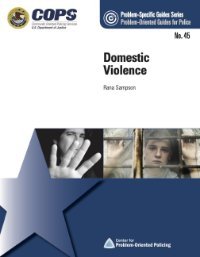This guide addresses serious youth gun violence, describing the problem and reviewing factors that increase the risks of it. It then identifies a series of questions that might help you analyze your local problem. Finally, it reviews responses to the problem, and what is known about them from evaluative research and police practice. Criminal misuse of guns kills or injures tens of thousands of Americans every year. In 2000, more than 10,000 Americans were killed with guns, and guns are much more likely to be used in homicides of teens and young adults than in homicides of people of other ages.
This guide begins by describing the problem of domestic violence and reviewing factors that increase its risks.† It then identifies a series of questions to help you analyze your local domestic violence problem. Finally, it reviews responses to the problem and what is known about these from evaluative research and police practice. Domestic disputes are some of the most common calls for police service. Many domestic disputes do not involve violence; this guide discusses those that do, as well as the measures that can be used to reduce them.
This guide begins by describing the problem of burglary at single-family house construction sites and reviewing the factors that increase its risks. It then identifies a series of questions that can help analyze your local burglary problem. Finally, it reviews responses to the problem of burglary at single-family house construction sites as identified through research and police practice.
Read more at the Center for Problem Oriented Policing
There is new concern about school violence, and police have assumed greater responsibility for helping school officials ensure students’ safety. As pressure increases to place officers in schools, police agencies must decide how best to contribute to student safety. Will police presence on campuses most enhance safety? If police cannot or should not be on every campus, can they make other contributions to student safety? What are good approaches and practices?
Read more at the Center for Problem Oriented Policing
The guide begins by describing the problem and reviewing factors that increase the risk of bomb threats in schools. The guide then identifies a series of questions that might assist you in analyzing the local problem of bomb threats in schools. Finally, the guide reviews responses to the problem and what is known about these from evaluative research and police practice.
Read more at the Center for Problem Oriented Policing
This guide begins by describing the problem of bank robbery and reviewing the factors that increase its risks. It then identifies a series of questions to help you analyze your local bank robbery problem. Finally, it reviews responses to the problem of bank robbery as identified through research and police practice.
Read more at the Center for Problem Oriented Policing
This guide deals with the problem of assaults in and around bars.§ We know a lot about the risk factors for these assaults, and about effective responses to them. We know less about which particular responses are most effective in addressing specific aspects of the problem. Therefore, your challenge will be to conduct a good analysis of the local problem, guided by the information presented here, and put together the right combination of responses to address that problem.
Read more at the Center for Problem Oriented Policing
This guide begins by describing the problem of animal cruelty and reviewing factors that increase its risks. It then identifies a series of questions to help you analyze your local animal cruelty problem. Finally, it reviews responses to the problem and what is known about these from evaluative research and police practice.
Read more at the Center for Problem Oriented Policing
By John Klofas • Irshad Altheimer • Nicholas Petitti
This guide begins by describing the problem of retaliatory violent disputes and reviewing factors that increase the risks of such disputes. It then identifies a series of questions to help you analyze your local retaliatory violent disputes problem. Finally, it reviews responses to the problem from evaluative research and police practice. Although the guide draws heavily on the authors’ research and practice findings from the BJA/CNA Strategic Innovations in Policing-funded initiative in Rochester, New York—one of the few police initiatives explicitly focused on retaliatory violent disputes—the information in this guide is also supported by the broader body of research and practice on retaliatory violent disputes.
Read more at the Center for Problem Oriented Policing










